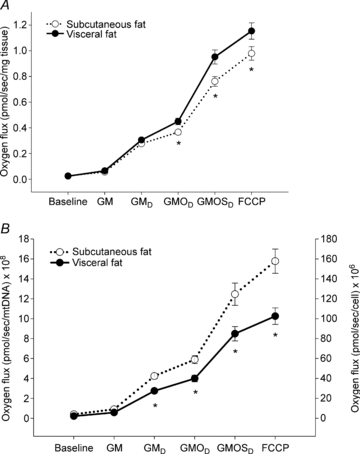Mitochondrial respiration in subcutaneous and visceral adipose tissue from patients with morbid obesity
- PMID: 20421291
- PMCID: PMC2911209
- DOI: 10.1113/jphysiol.2009.184754
Mitochondrial respiration in subcutaneous and visceral adipose tissue from patients with morbid obesity
Erratum in
- J Physiol. 2010 Oct 15; 588(Pt 20):4055
Abstract
Adipose tissue exerts important endocrine and metabolic functions in health and disease. Yet the bioenergetics of this tissue is not characterized in humans and possible regional differences are not elucidated. Using high resolution respirometry, mitochondrial respiration was quantified in human abdominal subcutaneous and intra-abdominal visceral (omentum majus) adipose tissue from biopsies obtained in 20 obese patients undergoing bariatric surgery. Mitochondrial DNA (mtDNA) and genomic DNA (gDNA) were determined by the PCR technique for estimation of mitochondrial density. Adipose tissue samples were permeabilized and respirometric measurements were performed in duplicate at 37 degrees C. Substrates (glutamate (G) + malate (M) + octanoyl carnitine (O) + succinate (S)) were added sequentially to provide electrons to complex I + II. ADP ((D)) for state 3 respiration was added after GM. Uncoupled respiration was measured after addition of FCCP. Visceral fat contained more mitochondria per milligram of tissue than subcutaneous fat, but the cells were smaller. Robust, stable oxygen fluxes were found in both tissues, and coupled state 3 (GMOS(D)) and uncoupled respiration were significantly (P < 0.05) higher in visceral (0.95 +/- 0.05 and 1.15 +/- 0.06 pmol O(2) s(1) mg(1), respectively) compared with subcutaneous (0.76 +/- 0.04 and 0.98 +/- 0.05 pmol O(2) s(1) mg(1), respectively) adipose tissue. Expressed per mtDNA, visceral adipose tissue had significantly (P < 0.05) lower mitochondrial respiration. Substrate control ratios were higher and uncoupling control ratio lower (P < 0.05) in visceral compared with subcutaneous adipose tissue. We conclude that visceral fat is bioenergetically more active and more sensitive to mitochondrial substrate supply than subcutaneous fat. Oxidative phosphorylation has a higher relative activity in visceral compared with subcutaneous adipose tissue.
Figures




References
-
- Boden G, Homko C, Mozzoli M, Showe LC, Nichols C, Cheung P. Thiazolidinediones upregulate fatty acid uptake and oxidation in adipose tissue of diabetic patients. Diabetes. 2005;54:880–885. - PubMed
-
- Bogacka I, Xie H, Bray GA, Smith SR. Pioglitazone induces mitochondrial biogenesis in human subcutaneous adipose tissue in vivo. Diabetes. 2005;54:1392–1399. - PubMed
-
- Dahlman I, Forsgren M, Sjogren A, Nordstrom EA, Kaaman M, Naslund E, Attersand A, Arner P. Downregulation of electron transport chain genes in visceral adipose tissue in type 2 diabetes independent of obesity and possibly involving tumor necrosis factor-α. Diabetes. 2006;55:1792–1799. - PubMed
-
- Deveaud C, Beauvoit B, Salin B, Schaeffer J, Rigoulet M. Regional differences in oxidative capacity of rat white adipose tissue are linked to the mitochondrial content of mature adipocytes. Mol Cell Biochem. 2004;267:157–166. - PubMed
Publication types
MeSH terms
Substances
LinkOut - more resources
Full Text Sources
Medical

